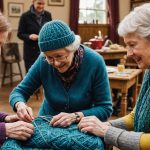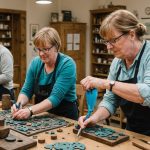Overview of Knitting Communities in the UK
Genuine knitting communities in the UK hold a cherished place among enthusiasts, providing not just a hobby, but a way to cultivate friendships. These groups, often gathering through UK knitting clubs and traditional knitting networks, play a pivotal role in preserving the art of knitting. The historical roots of knitting date back centuries in the UK, where it was once a household necessity. Over time, these communities have evolved into spaces for creativity and social interaction.
Knitting communities offer a blend of tradition and modern fellowship. For those involved, it’s about more than crafting warm garments; it’s an opportunity to share stories, laughs, and sometimes, a cup of tea. Members find value in learning new skills, exchanging techniques, and joining in shared projects that often support charities or local causes. Participation also opens doors to discovering rare patterns and styles, keeping the craft dynamic.
Have you seen this : Uncover the top locations for an immersive english baking experience!
Expect diverse gatherings— from clubs focusing on specific knitting types, to groups welcoming all forms of fibre arts. These communities maintain the charm of knitting while adapting to the contemporary needs of their members. To engage, explore UK knitting clubs that align with personal interests or offer a welcoming environment for learning and creativity.
In-Person Knitting Groups
Local knitting groups across the UK have a rich tapestry of offerings for both novice and seasoned knitters. These groups meet regularly in major cities, such as London, Edinburgh, and Manchester, creating spaces where creativity and camaraderie flourish. Knitting meetups often take place in cosy cafes, community centres, or even public libraries, offering a welcoming environment for participants.
Have you seen this : Uncover hidden gems: the top destinations for genuine british blacksmithing workshops
Community knitting events are not just limited to crafting; they frequently include social gatherings, workshops, and charity knitting projects. These activities allow members to share skills, patterns, and engage in meaningful conversations. For those wondering how to become a part of these vibrant groups, membership is typically informal, with many clubs open to drop-ins and casual participation.
Joining a group can be as simple as visiting a local cafe hosting a knitting night or checking online listings for events in your area. Being part of such communities provides invaluable opportunities for networking and learning. Some groups may ask for a nominal fee to cover event expenses, but many rely on contributions from members or host venues. By participating, knitters enjoy the dual benefit of enhancing their craft while building new friendships.
Online Knitting Platforms
Virtual knitting communities offer an inclusive space for knitters to connect, spanning geographical boundaries and time zones. These platforms have revolutionized how knitters share patterns, techniques, and ideas. Online knitting forums such as Ravelry and KnitTalk allow members to discuss projects, solve knitting dilemmas, and showcase their latest creations. They provide organised categories for various knitting interests, making it easier for users to find and contribute relevant content.
Within these digital knitting groups, features like video tutorials, live chats, and project galleries enhance the learning and sharing experience. Users can follow trends, participate in challenges, and even collaborate on projects virtually. Unlike traditional settings, virtual groups cater to diverse schedules, allowing participants to engage whenever they can.
When comparing platforms, user engagement is crucial. Forums that encourage active participation with interactive tools tend to thrive. Consider how platforms support community-building elements like feedback mechanisms and user interfaces. Whether you want a space to showcase your projects or seek advice on intricate patterns, finding the right online community can greatly enhance your knitting journey. Engaging in these forums provides an invaluable opportunity for continuous learning and connecting with a global network of enthusiastic knitters.
Member Testimonials and Stories
Embarking on a journey with knitting communities can transform your crafting experience. Many members share passionate testimonials that underline the profound impact of these groups on their personal and creative growth. For some, it’s the camaraderie found in knitting community experiences that enriches their day-to-day life, offering support beyond just knitting.
Listening to member stories reveals a spectrum of benefits. One member describes how regular participation not only honed their crafting skills but also helped cultivate lasting friendships. They recount moments of creativity sparked by collaboration with other enthusiasts, which led to ambitious projects and innovative designs. Such community support encourages knitters to push the boundaries of their skills and imagination.
Another member enthuses about the satisfaction derived from sharing knowledge. They highlight the beauty in teaching newer knitters, ensuring that traditional techniques are preserved while new methods are embraced. The act of guidance fosters a nurturing relationship within the community, enhancing the learning experience for all involved.
These knitting community experiences demonstrate how engaging with others can elevate individual pursuits. By embracing opportunities to learn from and teach one another, knitters find a sense of belonging and inspiration, fueling both their passion and creativity in meaningful ways.
Opportunities for Learning and Growth
Joining a knitting community presents an excellent avenue for both knitting skills development and personal growth. Many communities offer structured mentorship programs, pairing experienced knitters with novices to foster learning. These programs not only teach technical skills but also help build relationships, creating a supportive environment for all members.
In addition to mentorship, these groups typically host a variety of workshops and classes aimed at knitting education. Such sessions cover a range of topics, from basic techniques to more advanced methods, enabling members to tailor their learning to their interests and skill levels. Participants can explore new patterns, materials, and tools with guidance from instructors who bring a wealth of experience to the table.
Many groups encourage members to share knowledge and resources, emphasizing the communal aspect of learning. This sharing culture strengthens the community as everyone contributes to a collective pool of expertise. Informal gatherings often lead to spontaneous skill demonstrations or problem-solving sessions, further enriching the educational experience.
By engaging in these diverse opportunities, knitters not only enhance their craft but also build a network of supportive peers. This collaborative spirit is a cornerstone of knitting communities, empowering members to continually grow both creatively and personally.
How to Get Involved
Engaging with knitting communities holds the key to enriching your crafting journey. Taking the first step towards joining knitting communities begins with identifying your interests. Are local, in-person groups appealing, or does the flexibility of online forums suit your schedule better?
Begin by exploring platforms like Ravelry or social media groups on Facebook and Instagram that cater to specific knitting interests. These digital spaces offer a plethora of options, from specialized forums to general groups that welcome all knitting enthusiasts. Once you find an appealing community, review their rules, past discussions, and member testimonials to ensure it aligns with your preferences.
For those seeking in-person connections, local libraries, cafes, or community centers often host knitting meetups. These gatherings provide an excellent opportunity to engage directly with fellow knitters. Most groups have an open-door policy, inviting newcomers to join with ease. Participating in these events can also be a pathway to discover niche knitting communities that focus on particular techniques or projects.
Fostering connections with knitters could involve attending workshops, volunteering in community events, or simply sharing your work and experiences. The effort to connect with knitters enriches your skills, broadens your knowledge, and cultivates friendships within these vibrant communities.











